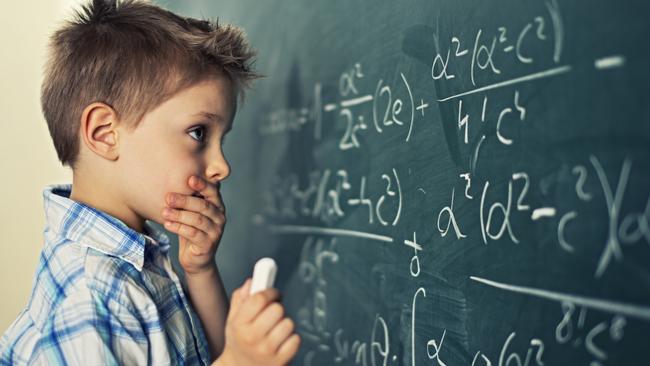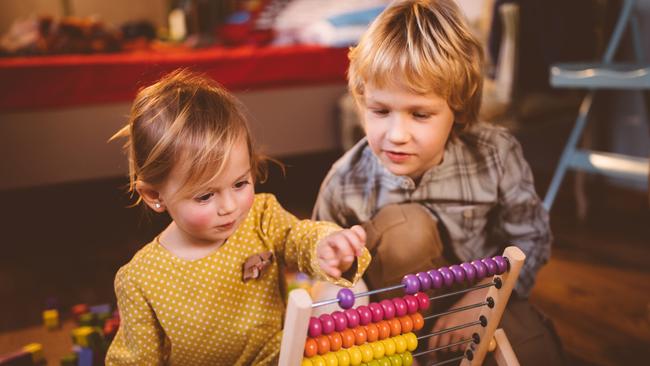How to support Victorian students with maths homework during remote learning
As Victorian students settle into remote learning there’s one subject that can be tricky for kids and their parents - maths. Here’s some expert advice on how to support your children with their work.

Many parents may be nervous about helping their children with the mathematics work they expect to be sent home from school in Term 2.
But parents need to remember that their role during remote learning is to support and encourage their child, not to teach them how to do maths.
Parents should help build a positive attitude to learning. Use phrases such as, ‘I can see that you don’t know how to solve this yet, but you will know how to soon’. This helps emphasise a growth mindset for your child and reminds them that not everyone is born with a fixed set of intelligence. We all have to work at things to learn new things.
Encourage your child to try different ways of solving a maths problem if they don’t get it right the first time.
Parents should make sure they are not doing the work for the child. Instead they need to:
– Provide the right amount of support at the right time
– Allow students to feel comfortable taking risks with their learning
– Use open-ended questions to encourage your child to think aboutr the problem
– Help the child understand they are responsible for their learning and owning their work.
Today, the Kids News’ Learning At Home program has partnered with Evidence For Learning to analyse a key Maths teaching technique in four age categories to assist parents in understanding what their children may be learning.

MATHS TIPS
PREP to YEAR 2
Place value
What is it?
Place value is the value of a digit where it appears in the number.
In 352, the 5 is in the “tens” place, so its place value is 10. It means understanding that 352 is made up of 300, 50 and 2, rather than 3, 5 and 2.
Why does my child learn this?
It helps them understand the meaning and value of a digit, which they will use for the rest of their life. It provides a foundation for changing groups of ones into tens, multiple-digit multiplication, and more in the decimal system. It also helps them understand money.
Common mistakes
1. Reversing numbers in place value, such as 13 instead of 31.
2. Little or no understanding of numbers beyond 10 (e.g. 16 is 10 and 6 more).
3. Not being able to count confidently to 10 or imagine what these numbers look like as a collection (e.g. child does not see 6 as one more than 5, one less than 7, or 3 plus 3).
Tips for Parents
1. Check the numeracy activities provided by your child’s school. Where possible, make those numbers and concepts a part of everyday learning in your house, similar to how you read to your child every night. Ask them to count the number of potatoes you are peeling, the number of eggs in a carton, how many kids are at the park etc.
2. Use household items such as Lego blocks or pens to help children to understand that numbers can be groups of 1. For eg. 5 = 5 groups of 1 and 8 = 8 groups of 1. Progress to understand that 10 can also be 1 group of 10 and 5 can be 1 group of 5.
3. Practice ‘skip’ counting by counting by 5s and 2s and 10s in front of your child.
4. Help children to understand the difference between 1-digit numbers (0-9), 2-digit numbers (10 to 99) and 3-digit numbers (101-999). Use Lego blocks to help with this concept. Give the blocks a different value. For eg. green = 10 and blue = 1. To represent 53, for example, use 5 groups of 10-green blocks (50) and 3 single blue blocks (3).
MORE NEWS:
HOW TO CARE FOR YOUR OVER WASHED HANDS
DELICIOUS, INEXPENSIVE FAMILY SOUPS
CLEANING MUST-DOS TO KEEP VIRUS AT BAY
YEARS 3-4
Fractions
What is it?
A fraction is one number that represents a part of a whole.
Why does my child learn this?
Fractions are important because they tell you what portion of a whole you need, have, or want. And they are used in everyday life including baking to tell how much of an ingredient to use and time when each minute is a fraction of the hour.
Common mistakes
1. Thinking the fraction is two whole numbers instead of one part of a whole.
2. Not understanding that there can be more numbers between zero and 1 and between all the other numbers.
3. Not recognising that fractions can be displayed in a variety of ways such as in numerals, lengths, volume, ratios and area.
Tips for Parents
1. Don’t expect your kids to understand fractions straight away. It is a difficult concept for young minds to grasp. Fraction sense builds over time and concepts related to fractions are developed over a number of years in primary school.
2. Check the concepts and activities related to fractions provided by your child’s school. Where possible, start introducing fractions into everyday life and talk about them with your kids. For eg, if you are having pizza, let them cut the pizza and explain they have created two halves, or quarters, or eighths. Then ask them to place one piece of pizza on a plate and explain that they have place one quarter on a plate and there are three quarters left etc.
3. Remind them often that a fraction is one number – ‘a’ quarter or ‘a’ half.
4. Every time you mention a fraction, draw it for your child. Commonly used representations are circles or squares. Then write the fraction next to the image so they understand it can be shown two ways.
5. Explain to your child that the larger the denominator (bottom number) in a fraction means there are more parts (or smaller parts) to the whole.

YEARS 5-6
BODMAS
What is it?
BODMAS is an acronym or mnemonic used to help pupils remember the correct order to complete mathematical calculations in (this called ‘order of operations’).
Why does my child learn this?
When your child has to complete a mathematical number sentence involving several different operations then BODMAS helps them to know which order to complete them in.
Common mistakes
1. Not working left to right when using addition and subtraction; and multiplication and division.
2. Double use of numbers. Some kids will accidentally use a number twice in two different operations.
3. Not rewriting the grouping symbols properly as they solve the problem (ie, keeping the addition or subtraction or multiplication symbols where they belong.
Tips for Parents
If your child is struggling to get the correct answer for a mathematics question provided by their teacher, prompt them to review the order of operations that they used. If they are still having trouble, remind them of the order of operation known as BODMAS which stand for:
B – Brackets
O – Others (roots and powers)
D – Division
M – Multiplication
A – Addition
S – Subtraction
Note for parents: division and multiplication, rank equally and are completed in order from left to right AND addition and subtraction rank equally and are completed in order from left to right)
To solve the following equation:
4² + (7 + 3) ÷ 5 – 8 x 2
you would use the order of operations by using:
1. Brackets first:
4² + (7 + 3) ÷ 5 – 8 x 2
becomes 4² + 10 ÷ 5 – 8 x 2
2. Then do the Others:
4² + 10 ÷ 5 – 8 x 2
becomes 16 + 10 ÷ 5 – 8 x 2
3. Then do the Division and Multiplication from left to right
16 + 10 ÷ 5 – 8 x 2
becomes 16 + 2 – 16
Then finally Addition and Subtraction from left to right
16 + 2 – 16
becomes 18 -16 = 2
Final answer = 2
YEARS 7-12
Reasoning
What is it?
The ability to think about something in a logical, sensible way. Reasoning requires questioning, deducing, analysing, explaining, inferring and justifying.
Why does my child learn this?
To learn how to evaluate situations, select problem-solving strategies, draw logical conclusions, develop and describe solutions, and recognise how those solutions can be applied in everyday life.
Students are reasoning mathematically when they explain their thinking, when they deduce and justify strategies used and conclusions reached, when they adapt the known to the unknown, when they transfer learning from one context to another, when they prove that something is true or false and when they compare and contrast related ideas and explain their choices.
Common mistakes
1. Thinking a problem can be solved only one way or with one method.
2. Having unquestioning faith in calculators or relying too much on rule-based procedures without understanding the mathematical concept.
3. Thinking a problem is too hard and giving up too easily. Reasoning is expected to stretch children’s thinking.
Tips for parents:
1. For any maths problems provided by your child’s school, encourage your child to gather and interpret all the necessary information to solve the problem and make informed decisions.
2. For these maths problems, ask them why they think their answer is right. If they can tell you how they arrived at their answer, they can more easily pinpoint the logical thinking that was involved. You could also ask them to work with siblings or with other students online to justify to each other how they got an answer and to analyse the other child’s reasoning.
3. To assist your child’s reasoning, have them ask questions such as, “What is the same?” and “What is different?”. Or ‘Prove it’ or ‘Convince me’ …
This develops their skills to compare and contrast by noticing and describing things, explaining and justifying, thinking analytically, using logic and focusing on important features.
4. If your child is struggling with reasoning, ask them to draw the information. Often this helps to convey the information in ways that words cannot.
5. Encourage your child to use language that includes If-Then statements. This is vital for ensuring they are working through the problem logically.
6. Don’t let your child give up too quickly. Remind the child that there are often multiple ways to approach a problem. Much can be learned by examining different solutions to the same problem and looking for similarities in solution approaches to different problems.
* Evidence for Learning is a non-profit, independent national organisation whose mission is to help educators increase learning through better research. Kidsnews.com.au, a free educational news literacy site, is partnering with Evidence for Learning to make sure the advice and suggestions given to parents to support learning at home is informed by the best available evidence.
